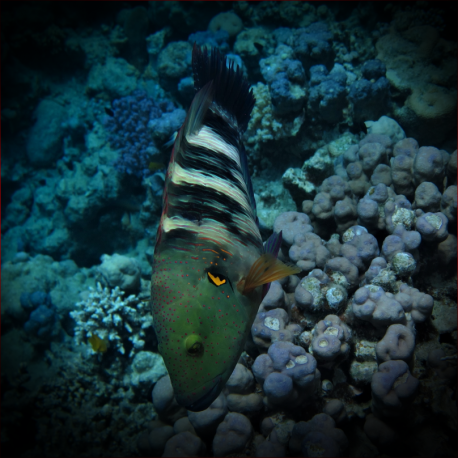More info
Datasheet
| Minimum Tank Size | 1000 litres / 264.17 US gallons |
| Maximum Size | 45.0cm / 17.72inches |
| Reef Compatible | Not reef safe |
| Temperament | Might be aggressive towards other species |
| Temperature | 22.2°C / 71.96°F - 25.6°C / 78.08°F |
| Specific Gravity | 1.020-1.025 |
| Carbonate Hardness | 8-12 |
| pH | 8.1-8.4 |
General Description: Tripletail wrasse, scientifically known as Cheilinus trilobatus, belongs to the Labridae family and can grow up to an impressive 45.0cm, larger than most wrasses. This species, commonly found in the Indo-Pacific region from East Africa to the Tuamoto and Austral islands, boasts vibrant colors and a striking appearance that sets it apart in aquarium settings.
Aquarium Suitability: The Tripletail wrasse is deemed suitable for aquariums, though with caution as it can pose a threat to small fish and many invertebrates such as shrimps, crayfish, crabs, and sea urchins. When fully grown, these creatures demand a very large aquarium due to their size, with precise dimensions unspecified but noted to surpass the capacity of a typical home aquarium.
Care and Hardiness: With an average hardiness level, these wrasses require diligent care in the aquarium. They thrive best when provided with ample space for swimming and adequate hiding places like live rocks. Their diet should be varied, including live foods initially and large pieces of seafood thereafter, offered every day or every other day.
Reef Suitability: Despite their attractiveness and useful presence in battling certain unwanted invertebrates, Tripletail wrasses are not considered reef-safe due to their predatory nature towards various reef inhabitants.
Aquarium Setup: Proper aquarium setup for these wrasses involves securing rocks on the substrate to prevent toppling, offering hiding spaces for acclimation, and ensuring a spacious environment conducive to their swimming habits.
Behaviour: Tripletail wrasses may exhibit aggression towards other species upon introduction, and they are easily stressed by unfamiliar tank mates or disturbances during acclimatization. They tend to hide initially as they adjust to their new environment.
Feeding and Diet: A varied diet including fish, crustaceans like shrimp and crabs, and other invertebrates is essential for the well-being of Tripletail wrasses. Offering live food can increase their chances of acclimation and long-term success in captivity.
Dimorphism (and Captive Reproduction if covered): Tripletail wrasses can change gender from female to male when the need arises, a unique trait among this species that contributes to their reproductive dynamics in captivity.
Habitat and Distribution: Indigenous to the East Indian Ocean, West Indian Ocean, Australia, Japan, The Red Sea, Indonesia, and various parts of the Pacific, Tripletail wrasses inhabit a wide geographical range from East Africa to the Ryukyu Islands and south to New Caledonia.

